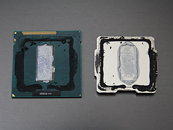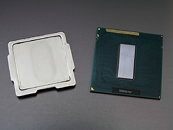Saturday, May 12th 2012

TIM is Behind Ivy Bridge Temperatures After All
It's proven: the thermal interface material (TIM) used by Intel, inside the integrated heatspreader (IHS) of its Core "Ivy Bridge" processors are behind its higher than expected load temperatures. This assertion was first made in late-April by an Overclockers.com report, and was recently put to test by Japanese tech portal PC Watch, in which an investigator carefully removed the IHS of a Core i7-3770K processor, removed the included TIM and binding grease, and replaced them with a pair of aftermarket performance TIMs, such as OCZ Freeze and Coolaboratory Liquid Pro.
PC Watch findings show that swapping the TIM, if done right, can shave stock clock (3.5 GHz, Auto voltage) temperatures by as much as 18% (lowest temperatures by the Coolaboratory TIM), and 4.00 GHz @ 1.2V temperatures by as much as 23% (again, lowest temperatures on the Coolaboratory TIM). The change in TIM was also change the overclockability of the chip, which was then able to sustain higher core voltages to facilitate higher core clock speeds. The report concluded that Intel's decision to use thermal paste inside the IHS of its Ivy Bridge chips, instead of fluxless solder, poses a very real impact on temperatures and overclockability.
Source:
PC Watch
PC Watch findings show that swapping the TIM, if done right, can shave stock clock (3.5 GHz, Auto voltage) temperatures by as much as 18% (lowest temperatures by the Coolaboratory TIM), and 4.00 GHz @ 1.2V temperatures by as much as 23% (again, lowest temperatures on the Coolaboratory TIM). The change in TIM was also change the overclockability of the chip, which was then able to sustain higher core voltages to facilitate higher core clock speeds. The report concluded that Intel's decision to use thermal paste inside the IHS of its Ivy Bridge chips, instead of fluxless solder, poses a very real impact on temperatures and overclockability.




219 Comments on TIM is Behind Ivy Bridge Temperatures After All
If the 3770k is is doing 34C on idle and 61C on load i thinks its fine.
61C @ 3.9ghz on stock cooler
84C @ 5ghz on stock cooler
Unless everyone missed the part where he left Turbo Boost on the chip turned on.
For Air cooling I think thats fine
As a side note, Mussles, you live a couple hours away from me. Wanna take my IHS off, reapply some good TIM and then put the IHS back on and see if we see a nice drop in temps? :P
Seriously though, if Intel offered a optional recall to have better TIM on it as a revision, i'd take it in a heart beat. Free new CPU with cooler temps!
I would totally do this to a $300 or less cpu. Not to a more expensive one though, at least not until it's already out of warranty. That's the entire reason my 980 still has it's lid. lol.I'd have to agree there. If I were building a new system, I would definitely go IB though. The only way I would go from SB to IB is if I were going from a 2500 to a 3770 to gain hyperthreading.
All this TIM thing is a bad move, that ihs is for protection against damage and uneven pressure that could crush the transistors.
For average users those temps are going to escalate in time since tim gets bad after long periods to the point that will harm the CPU. For the average overclocker it's the worst, its hard to have the guts to maybe potentially destroy the CPU. Removing that thing is tricky.
Why would intel release a product that is worse for 99% of customers and better for 1%?
removing the ihs and replacing the tim and putting back the ihs is just proving that it was the worst idea ever. Fixing their job, really? There is only 2 options, use it as is and have bad temps, and remove it risking losing the high value chip for better temps.
Sure the 3 option is remove it, place new tim and place it again, but again this is just proving how bad this design is.
I hope this won't happen ever again and is fixed with new revisions. If they wish to get that 1% release batches with tim, like 3750kk? or something
A 3770k on Turbo Boost will upscale 400mhz.
Disruptor4 said he was using a Coolermaster Hyper 212 Evo with Arctic Silver 5 paste and the reviewer is using a Thermalright Silver Arrow
So before he take out the TIMMY!!!!:rockout:
Hes getting 5ghz on load when he leaves Turbo Boost on at 4.6ghz@1.2V witha max temp of 84C
Focus on the top bar :twitch: on each run
If you go to this chart before he removes poor one legged TIMMY!!!!:rockout:
Hes able to base clock it to 4.9ghz@1.45V and run Cinbench without a Themal Shutdown so if Turbo Boost is on hes getting 5.3ghz before reaching 105C
Thats not bad Air Cooled considering Sandy-Bridges had issues getting to 4.5ghz stable. Factor in the SB to IB differance and its like running a Sandy-bridge at 5.6ghz air cooled.
Focus on first table :twitch:
For Socket 939 was not needed also The 462 Palomino chips,Just clarify the year 2000-2001 ;) We seen the first IHS on AMD when socket(first gen x64 cores) 754 I think was out for a short time before the X64 send gen 939 boards.
en.wikipedia.org/wiki/Duron
en.wikipedia.org/wiki/Socket_754
Hm for Intel to do this ,They must have some reason,Do I think it is bad?, maybe Seeing how some user want to overclock the IB chip,But why I think SB is the better of the two.
LOL, just kidding. I expect Intel may address this with later revisions and start using more traditional fluxless solder. It is something of a blessing to some though, just don’t crush your core in the process.
My theory was that the chip got too hot even with fluxless solder so fusing it to the heat spreader may result in weakening its electrical connections as the heat spreader heats and cools (expands / contracts). However, that’s probably not likely if the solder can help keep the temp down, which this artical seems to suggest,....
IT WORKS
will replacing the tim help,,, yes.
but ALL of the air heatsinks and water cooling cpu blocks were designed for use with a heatspreader...if only 1 heatpipe crosses your poor lil ivy chip, what good is that???
Sure they may get hotter with over clocking in comparison to Sandy Bridge but still beats the offerings of any chip of any other manufacturer.
So they can cheap out and still be ahead.
would you mind elaborating a little on what it is you're asking? i'm sure between cadaveca, Aquinus, and me we'll be able to answer.
thats not what the physics say at all!!!
here...this is from XtreemSystems......there are some seriously smart mf'rs on this site....
Some people will read get 10-25C better temps by removing the IHS, then do so, and get disappointed when they see 15+C higher temps and realize they ruined their cpu.
Nobody gets 10-25C better temps by removing the IHS on a modern high power density 100W+ cpu, though a few claimed it without proof. I have removed the IHS on a few and my temps were worse as has another person that posted pics in previous thread with before/after temps. Old 40w cpus that just used paste, yes, those you could remove the ihs and get better temps, since replacing paste with paste and removing a layer.
2/3 or more of the gradient in modern cpus is from hot spot through the die substrate, that is via stanford article linked and pics in post here, also from drilling holes through ihs with calibrated thermocouples on ihs and in die. The copper laden die has thermal conductance of ~125W/MK, solder attach 80 w/mK but is only 20 microns thick, and copper is 400 w/mk, hence one would expect most of gradient is through the die. Also you can load 2 cores with coredamage/prime (set affinity in task bar to load just 2 cores of 4) and you will see 20C gradient from loaded core to idle core, which demonstrates high gradient through die substrate, like pic below in slide from ESL.
You could get ~10C better temps (assuming 150W tdp and 30C gradient from core to IHS temps) by removing IHS, If you then solder on a waterblock with 80w/mk solder assuming you could avoid voids like intel, and assuming the same bondline thickness of ~20 microns). Then the waterblock is the heatspreader + eliminate user tim. The IHS isnt just protection, but for spreading heat to a much larger area at 80W/mk through only 20 microns thickness then at 400w/mk via copper, ie relatively rapidly to a relatively large surface area....before the end user puts on relative crappy 3-4W/mk tim paste at thickness higher than 20 microns, then tries to cool it with water 0.6w/mk or air, even worse.
But removing 80w/mk solder and replacing with 3-4 w/mK paste at a stage when heat is still confined to relatively small surface area, is a disaster that will result in 10-15C+ higher temps at stock alone.
These results DO NOT point at - IHS=lower temps
they point out a bad decision coupled by poor implementation on Intel's part